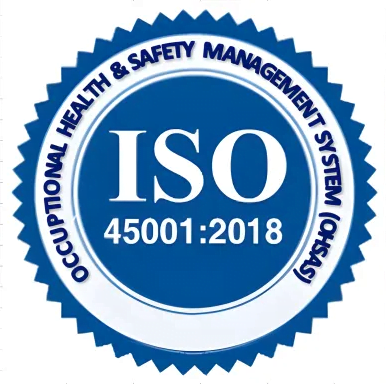Workplace safety is a non-negotiable priority for organizations across the globe. The well-being of employees and the prevention of workplace accidents are paramount concerns. To meet these objectives and adhere to international standards, organizations turn to ISO 45001:2018 – the Occupational Health and Safety Management System (OHSMS). ISO 45001:2018 OHSMS training is a pivotal element in achieving and maintaining compliance with this standard, instilling a culture of safety, and fostering excellence in occupational health and safety. In this comprehensive guide, we delve into the world of ISO 45001:2018 OHSMS training, its significance, key components, and the profound impact it has on workplace safety.
Understanding ISO 45001:2018 OHSMS:
ISO 45001:2018 is an international standard developed by the International Organization for Standardization (ISO). It sets out the criteria for an Occupational Health and Safety Management System (OHSMS) and provides a framework for organizations to establish, implement, maintain, and continually improve their occupational health and safety performance. The standard is designed to prevent workplace accidents and illnesses and ensure a safe and healthy working environment.
Role of ISO 45001:2018 OHSMS Training:
ISO 45001:2018 OHSMS training equips professionals with the knowledge and skills necessary to navigate the complexities of the standard. It prepares them to conduct effective assessments of an organization’s OHSMS, identify areas of non-compliance, and recommend improvements. These professionals play a pivotal role in promoting a culture of safety, ensuring compliance with ISO 45001:2018 standards, and facilitating the pursuit of OHSMS certification.
Key Elements of ISO 45001:2018 OHSMS Training:
The training to become proficient in ISO 45001:2018 OHSMS encompasses several key elements to equip professionals with the requisite expertise:
Understanding ISO 45001:2018:
Training begins with a comprehensive understanding of the ISO 45001:2018 standard. This includes the principles, requirements, and guidelines for implementing an effective OHSMS.
Audit Principles and Techniques:
OHSMS training explores the principles and techniques of conducting OHSMS audits. This includes audit planning, conducting the audit, reporting findings, and follow-up actions.
Audit Process:
Professionals learn the entire audit process, including the development of audit checklists, on-site audit conduction, documentation review, and effective communication of audit results to management.
Documentation and Compliance:
The training includes a deep dive into OHSMS documentation requirements and the importance of compliance. This ensures that professionals are well-versed in the documentation and reporting processes mandated by ISO 45001:2018.
Communication Skills:
Effective communication is a cornerstone of OHSMS training. Professionals learn how to interact with auditees, ask relevant questions, and convey audit results clearly and professionally.
Significance of ISO 45001:2018 OHSMS Training:
ISO 45001:2018 OHSMS training offers several critical advantages to organizations and the professionals who undertake it:
Workplace Safety:
OHSMS training ensures that organizations meet internationally recognized standards for workplace safety. This leads to the prevention of accidents, illnesses, and injuries in the workplace.
OHSMS Certification:
OHSMS professionals play a crucial role in helping organizations prepare for ISO 45001:2018 certification. Achieving this certification is a testament to an organization’s commitment to safety and well-being.
Risk Mitigation:
By assessing and identifying potential risks within an organization’s OHSMS, professionals contribute to the overall risk management strategy, ensuring that safety hazards are mitigated effectively.
Legal and Regulatory Compliance:
OHSMS training ensures that organizations adhere to legal and regulatory requirements related to occupational health and safety. This minimizes the risk of legal issues and non-compliance.
Operational Efficiency:
OHSMS audits often uncover inefficiencies in processes that compromise safety. Professionals help organizations streamline operations, resulting in cost savings and improved productivity.
Employee Well-being:
A safe working environment enhances the well-being and morale of employees. Professionals ensure that organizations prioritize employee safety, leading to greater job satisfaction and retention.
Stakeholder Trust:
ISO 45001:2018 certification is a mark of excellence in safety. Organizations that achieve it earn the trust of customers, employees, suppliers, and regulatory bodies.
Continual Improvement:
OHSMS professionals foster a culture of continual improvement in organizations. They provide recommendations for enhancing processes and practices, making safety a dynamic and evolving aspect of the workplace.
Challenges and Evolving Trends:
ISO 45001:2018 OHSMS professionals encounter challenges and must adapt to evolving trends within the field:
Pandemic Preparedness:
The COVID-19 pandemic highlighted the need for organizations to be prepared for infectious disease outbreaks. OHSMS professionals may need to adapt their safety protocols to address such crises.
Globalization:
As organizations operate in an increasingly globalized world, OHSMS professionals must be well-versed in international OHSMS standards and practices.
Technology Integration:
The integration of technology, such as digital safety management systems and health monitoring, is transforming OHSMS. Professionals need to adapt to the use of digital tools and data-driven decision-making in safety management.
Mental Health and Well-being:
The recognition of mental health as a significant aspect of overall well-being means that OHSMS professionals may need training in mental health first aid and well-being initiatives in the workplace.
The Future of ISO 45001:2018 OHSMS Professionals:
The role of ISO 45001:2018 OHSMS professionals will continue to evolve and expand in significance:
Digitalization:
With the increasing digitalization of safety management, professionals will need to stay updated with digital safety management systems, predictive analytics, and safety data integration.
Sustainability and ESG:
Organizations are placing greater emphasis on environmental, social, and governance (ESG) factors. OHSMS professionals may need to assess an organization’s commitment to these principles as they relate to workplace safety.
Complex Supply Chains:
As supply chains become more complex and global, OHSMS professionals will need to assess an organization’s ability to manage safety across a distributed supply chain effectively.
Integrated Management Systems:
Organizations are adopting integrated management systems that encompass quality, environmental, health, safety, and other management aspects. OHSMS professionals may need to adapt their audit approach to evaluate these integrated systems.
In conclusion, ISO 45001:2018 OHSMS training is a vital component of achieving and maintaining excellence in workplace safety. OHSMS professionals play a pivotal role in ensuring that organizations meet internationally recognized safety standards, fostering a culture of safety and well-being, and prioritizing employee welfare. As organizations continue to evolve and adapt to changing safety needs, OHSMS professionals will remain at the forefront of safety management, ensuring a safe and healthy working environment for all. OHSMS has now become significantly required by all the organizations throughout the world with the increase of their businesses.




